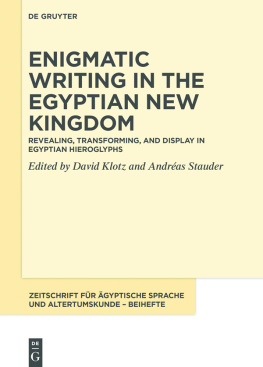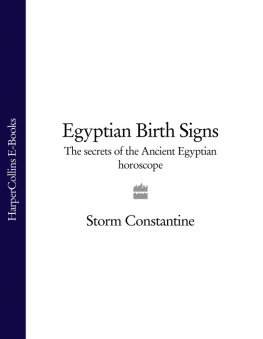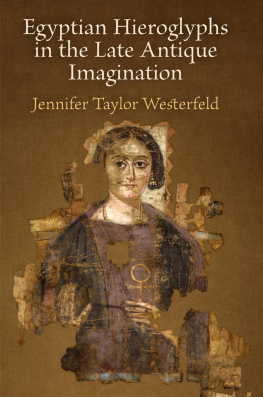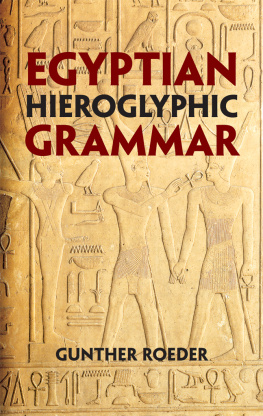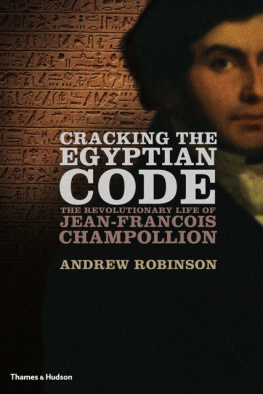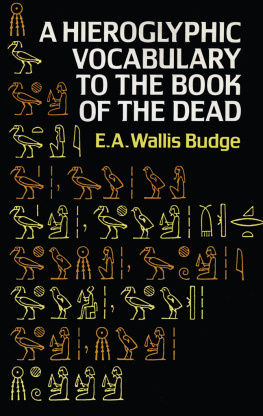Contents
Guide

Enigmatic Writing in the Egyptian New Kingdom I
Zeitschrift fr gyptische Sprache und Altertumskunde
Beihefte

Herausgegeben von
Susanne Bickel, Hans-Werner Fischer-Elfert,
Antonio Loprieno, Stefan Pfeiffer, Sebastian Richter
Beirat
John Baines, Elke Blumenthal, Julia Budka,
Richard Parkinson, Kim Ryholt,
Stephan Seidlmayer, Jean Winand
Band 12/1

Printed with the support of eikones Zentrum fr die Theorie und Geschichte des Bildes (Universitt Basel)
ISBN 978-3-11-068354-7
e-ISBN (PDF) 978-3-11-068388-2
e-ISBN (EPUB) 978-3-11-068398-1
ISSN 2198-5790
Library of Congress Control Number: 2020930386
Bibliographic information published by the Deutsche Nationalbibliothek
The Deutsche Nationalbibliothek lists this publication in the Deutsche Nationalbibliografie; detailed bibliographic data are available on the Internet at http://dnb.dnb.de.
2020 Walter de Gruyter GmbH, Berlin/Boston
www.degruyter.com
Preface
The present publication has it origin in a workshop held in Basel on 2324 May 2015 under the auspices of the National Center of Competence and Research eikones iconic criticism (Swiss National Science Foundation and Universitt Basel). Presenting participants in addition to the authors of this publication were Philippe Collombert, Antonio Loprieno, and Wolfgang Behr. We express our very warm thanks to Ralph Ubl, director of the NCCR eikones, and to Susanne Bickel, chair of Egyptology and of the Departement Altertumswissenschaften, both Universitt Basel, for their continuous support and hosting of the event. Our thanks go further to the editors of Zeitschrift fr gyptische Sprache, Beihefte for accepting this work in their series. We remain particularly grateful to Ralph Ubl and eikones for generous help with the publication costs.
Paris/Boston, 3 May 2019
Andras Stauder
Introduction
Egyptian enigmatic writing (also referred as cryptography, see below) can be broadly defined as a variety of extended practices of hieroglyphic writing that are set against immediate decoding, foreground the iconicity inherent in hieroglyphic writing, and invite a more absorbed or experiential engagement by the beholder/reader. Through these delays, enigmatic writing can reveal meaning beyond the linguistic sequence; in its particular visual presence and iconicity, it can be boldly affirmative and even transformative.
The present set of two volumes ( Studies and Lexicon ) concerns enigmatic writing at the time of its richest development, the New Kingdom ( c . 15501070 bce ). In individual groups of signs or extending over the whole inscription, enigmatic writing is then found in a variety of settings corresponding to three main traditions: royal settings, with, notably, monumental full-figured friezes in temples and over the entrance of royal tombs; non-royal settings, with enigmatic groups of signs in texts inscribed notably in the entrances of funerary chapels and on scribal palettes; and (sections of) Netherworld Books and related cosmographic compositions inscribed in enigmatic writing, mainly but not exclusively in sealed-off royal tombs. The traditions of enigmatic writing associated with these settings are diverse yet interrelated; as a whole, the phenomenon represents one major dimension of New Kingdom written culture.
The pragmatics of enigmatic writing vary with settings and people. In some of its settings, enigmatic writing is ostentatiously displayed, while in others it is withdrawn from general visibility. In the sealed-off underground appartements of royal tombs, enigmatic writing contributed transforming the place in which it was inscribed. When seen, enigmatic writing could create a complicity with the beholder able to solve its challenges and appreciate the wit and ingenuity that had gone into making it, and further serve as an index of a restricted in-group sociology and identity. enigmatic writing was also geared at broader audiences.
Hieroglyphic writing, in general, emphasizes the iconicity of the signs. Enigmatic writing, in its different instantiations, pushes this emphasis even further. It favors signs that have a high visual resolution, are highly iconic, carry culturally encyclopedic meaning, and/or are full-figured.
The heightened iconicity, visual otherness, and delayed reading associated with enigmatic writing also ground its performative dimensions. In appropriate contexts, such as on monumental friezes in sacral spaces, royal titularies inscribed in enigmatic writing could thus be seen as evoking the consubstantiality of the king with the gods, inscribing his name into the divine realm and turning it into a solar icon.
Interest in Egyptian enigmatic writing goes back to Champollion himself.
The studies in the present volume illustrate the diversity of traditions and practices of enigmatic writing in the New Kingdom (comprehensive overview by Darnell): in royal full-figured monumental friezes (Klotz), in private settings of the Eighteenth Dynasty (Diego Espinel), and in the Netherworld Books (Roberson, Werning, Stauder). Across these domains, they illustrate various approaches to enigmatic writing. The practice and method of decipherment are demonstrated in studies of RamsesII enigmatic frieze in the Luxor temple (Klotz) and of the Jackal Hymn in the Tomb of RamsesVI (Roberson). These show how proposed readings are validated based on textual parallels and on established principles of substitution and derivation (further, Roberson, Excursus). A sophisticated semiotic analysis of these principles of derivation and substitution is offered by Werning. Moving beyond the individual signs, the enigmatic text is considered in its specific visual dimensions and otherness (Klotz, Stauder, for two different traditions of enigmatic writing) and in its effects in bringing about a delayed and experiential reading (Darnell, Stauder). Addressing the high-cultural functions of enigmatic writing in its various settings, Darnell offers a general hermeneutics of enigmatic writing as transformative and as expressing significations that are liminal in nature.
The second volume of the set, A Lexicon of Ancient Egyptian Cryptography of the New Kingdom (Roberson, with contributions by Klotz), includes a comprehensive list of enigmatic values found in texts of the New Kingdom, with indications of their derivation, textual attestations, and when necessary references to the discussion. The Lexicon , including its introduction, is presented as a handbook for further research and to make the study of enigmatic writing more broadly accessible.
Collectively, these studies and the Lexicon illustrate the diversity of practices and traditions of enigmatic writing in the New Kingdom. They demonstrate that enigmatic writing is not some arcane and recondite tradition divorced from regular hieroglyphic writing. Enigmatic writing is based on the very principles of regular hieroglyphic writing, extending these. Set against instrumentalist ideologies of writing understood as an ideally transparent vehicle for linguistic meaning, Enigmatic writing pushes these very dimensions even further, delving deep into what makes a hieroglyph sign. A higher register of hieroglyphic writing, it is even more excessive: visually present, semantically dense, virtuosic. Through its enhanced iconicity, its visual otherness, and the resistance it affords to immediate decoding, enigmatic writing entices, challenges, dazzles. Through these delays, enigmatic writing invites to a more through-going experience of writing and opens to what, in native conception and absent substantial explicit meta-discourses, may have been conceived of as the very essence of hieroglyphic writing.

